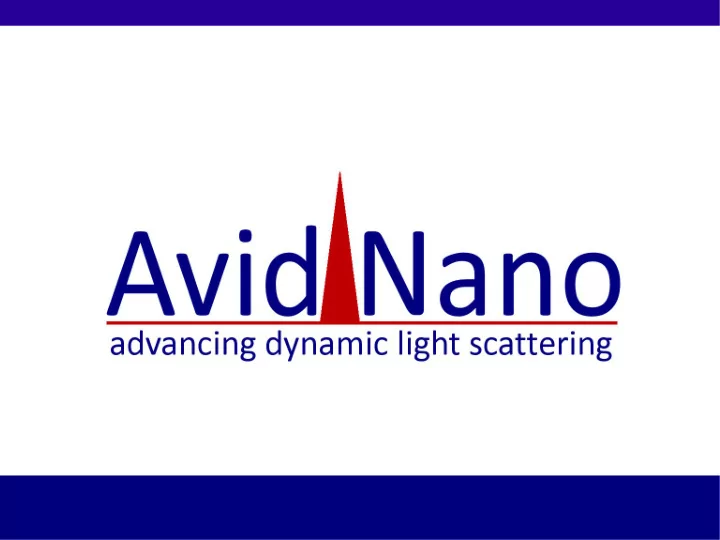

Contents About Avid Nano Dynamic Light Scattering Products Accessories
About Avid Nano Established in July 2009 Based in High Wycombe, UK Design & manufacture novel DLS
DYNAMIC LIGHT SCATTERING
Dynamic Light Scattering Observe time dependent intensity fluctuations of light to directly measure... – Hydrodynamic radius of molecules/particles in solution / suspension • Intensity size distribution • Mass size distribution • Aggregation • Molecular weight can be estimated
Ø40µm Let's describe this visually Scattering Volume
I time Scattering Volume
I time Scattering Volume
I time Scattering Volume
I time Scattering Volume
I time Scattering Volume
Looks like random I noise, but... ...small sizes diffuse more quickly than large sizes, so... time ...rate of change tells us the mean particle size
Dynamic Light Scattering Intensity pattern produces a correlation function and diffusion Correlation function gives diffusion constant, Dt Amplitude, G 2 constant, Dt. Calculate mean hydrodynamic radius, (Rh) and polydispersity index (PdI) Log 10 time (µs) Typical measurement time, 30s
Dynamic Light Scattering We can use the 'Stokes- Einstein' equation to easily calculate the average hydrodynamic radius, Rh KT Rh = 6 Dt
Size Distributions By comparing the measured data 1.2 to a series of artificial correlation Measured data data we can produce a size 1 distribution Artificial data 0.8 0.6 Intensity 0.4 0.2 0 0 0 0.01 0.1 1 10 100 1000 Size (nm)
Molecular Weight Model To estimate molecular 1000.0 Molecular Weight Estimator weight, we use a Common Gobular Proteins globular model derived from a curve of common proteins 100.0 MW (kDa) f(x) = 2.75 x^2.49 2.49 2.75 r Mw ~ 10.0 1.0 1.0 10.0 Monomer Radius (nm)
Molecular Weight Model The model works well for Molecule Size Est. MW MW many proteins (nm) (kDa) (kDa) Insulin (pH 2) 1.4 5.8 5.8 Lysozyme 2.0 14.5 14.7 Insulin (pH 7) 2.7 32.6 34.2 BSA 3.6 67.0 66.8 Hexokinase 4.3 104 102
Typical Results Intensity Mass Distribution Distribution Mean Size and Experiment name Polydispersity Distribution Ave. Correlation Table of Results Function
Example Data Highly monodisperse protein solution producing good quality crystals Narrow intensity peak Low polydispersity index Strong light scattering intensity from high concentration sample Mean radius 3.1nm used for molecular weight estimate (42kDa actual) Mean radius Mw Estimate
Example Data Mixture of certified standards High PdI indicates broad or multi- mode distribution Intensity peaks confirm bi-modal distribution. Light scatters proportionally to Rh^6 Mass distribution indicates the amount of 10nm material much greater than 100nm Mean radius. High Pd. Index
Example Data Overlaid Distributions Examples of mono-modal and multi-modal data. In each example we see normal variability caused by scattering intensity variation The size variability very low in main protein peak (7.1nm)
Dynamic Light Scattering Primary data – Mean hydrodynamic radius – Polydispersity index Secondary Data – Intensity size distribution – Mass size distribution – Molecular weight estimate
Applications Protein purification Aggregation Quick molecular weight estimate Micelle formation Thermal denaturing Colloids and nano-particles
Key Strengths Speed – especially with disposable cuvettes Incredible sensitivity to aggregation Requires little a priori knowledge Absolute measurement - no calibration Maintenance free
Products
W130i Designed for the protein specialist. – Unbeatable sensitivity (0.1mg/ml, 15kDa protein) – 5µl disposable cuvette (standard) – Temperature control (0-90°C) – Compatible with standard cuvettes
BladeCell Disposable Cuvette
BladeCell Disposable Cuvette DLS has reputation for being very useful but a bit tedious at times – Expensive quartz cuvettes – Cleaning required – Cross-contamination issues
BladeCell Disposable Cuvette DLS has reputation for being very useful but a bit tedious at times – Expensive quartz cuvettes – Cleaning required – Cross-contamination issues BladeCell cuvette solves problem – Only 5µl – No cleaning or reference m'ments – much faster than quartz – Full sample recovery – Zero cross-contamination
Future Developments
SMART-NANO S ensitive M e A su R emen T , detection, and identification of engineered NANO particles in complex matrices Commercializing hyper-sensitive DLS based on known light scattering techniques. Up to 10x sensitivity increase over current DLS performance. Suited to measurements at very low concentrations and for very small molecules Final negotiations September 2011. 2 year project commencing end 2011.
Thank you for watching
Recommend
More recommend